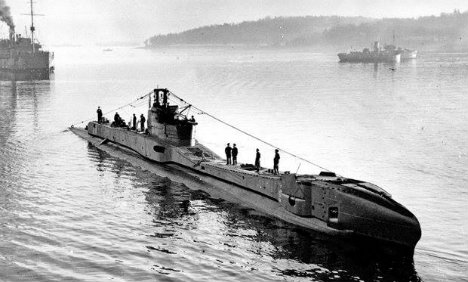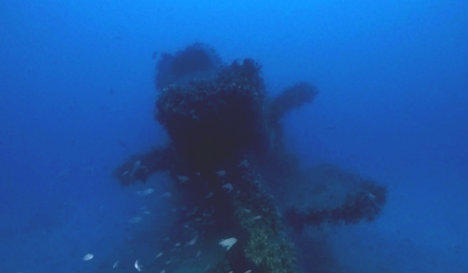Crew who sunk with WWII sub 'wanted to be found': relative

People were stunned by the discovery of a body-filled, Second World War-era submarine off the coast of Sardinia earlier this week, not least Paul Denison, who told The Local his great-uncle was among the 71 who perished on board.
“When I heard about it on Wednesday, I was astounded,” Denison a 44-year old train driver from Bolton said. “I can't explain why, but I've always had the feeling that the submarine's lost crew wanted to be found.”
The P311, a T class British submarine, vanished without a trace in 1943, after hitting a mine while on an almost suicidal mission to destroy the Italian battleships Trieste and Gorizia at anchor off the Sardinian island of La Maddalena.

The P311 in action. Photo: Wikimedia Commons.
“Able seaman Leonard Auty – my great-uncle on my mother's side – was on board when she went down,” Denison explained. “He died aged just 26, leaving behind his wife and a son he never met.
“My grandfather, his brother, was so devastated by the loss that he never really spoke of Leonard, which means I don't know so much about him," Denison said.
Still, Denison had spent the last couple of years researching the wreck in a bid to find out more, making the discovery on Tuesday even more intriguing.
The P311 sent its last signal more than 73 years ago - shortly after leaving Malta on December 31st 1942. It was presumed lost after failing to return to base on January 8th 1943.
“In order to join the submarine corps in those days, you had to be very brave,” Denison explained.
The casualty rate was very high and submariners lived in constant fear of mines and depth-charges - either of which could cause them to sink into the deep without a trace.
Despite the perils, Leonard Auty and the 70 other men aboad the P 311 spent years braving the depths of the Mediterranean and making excursions into enemy-infested waters.
Men like Auty proved instrumental in winning the war in North Africa by disrupting supply lines from Italy to General Rommel's troops.
“I'm immensely proud to be his relative,” Denison said. “Knowing what happened to the men and where they lie goes a long way to providing a sense of closure for the victims' families.”
The ultimate fate of P311 fate was still unknown until Italian wreck-hunter, Massimo Bondone, discovered the submarine's' 80 metre-long carcass off the coast of the La Tavolara, Sardinia, at a depth of 100 metres.

The wreck lies at 100 metres. Photo: Massimo Domenico Bondone.
“Obviously, finding a missing T class British submarine doesn't happen everyday. For sure it's one of the finds of my life – even if it is immensely poignant,” Bondone told The Local.
“The P311 was mythical in wreck-hunting circles and I'd obsessively been trying to locate its resting place since late 2015.”
Bordone, a 56-year-old diving instructor from Genoa, spent hours checking military records and learning as much as he could about the movements of British submarines between Malta and Sardinia in order to identify possible resting sites.
After doing his homework, he headed to Sardinia two months ago to begin searching the waters, and got lucky on his third dive.
“Between bad weather and other problems, I had only managed to check out two possible sites before I came across the ship.
“Since last Sunday I have been back down twice and will keep going to get as much footage as I can of it.”
The footage suggests the sub collided with a mine – sustaining structural damage to its prow before sinking.
Despite sinking after the strike, the craft is in excellent condition and Bondone suspects its inner chambers remained airtight. If he is correct, the crew died of asphyxiation after being marooned on the seabed and still lie sealed inside.
Although the remains of 71 servicemen are possibly still on board, a spokesman for the Royal Navy told The Local the likelihood of the vessel ever being raised is almost zero.
Sunken military ships are left to lie and are considered war graves, only being raised in cases of extraordinary historical or strategic significance.
“The Tudor-era navy battleship, Mary Rose, was raised from just outside Portsmouth harbour in order to preserve an important piece of history from rotting away under the water,” the spokesperson explained.
In other cases wrecks might be raised because they contain items of interest to national security, for example, an enigma-coding machine, but even then it is not certain.
“The costs and dangers involved in raising such a craft from the sea floor mean it only happens in the rarest of cases,” the spokesperson added.
“At the end of the day, so many submarines have sunk in exactly the same way. Consider that off the coast of the British Isles alone we have the graves of thousands of submariners – they should be left to rest in peace.”
Comments
See Also
“When I heard about it on Wednesday, I was astounded,” Denison a 44-year old train driver from Bolton said. “I can't explain why, but I've always had the feeling that the submarine's lost crew wanted to be found.”
The P311, a T class British submarine, vanished without a trace in 1943, after hitting a mine while on an almost suicidal mission to destroy the Italian battleships Trieste and Gorizia at anchor off the Sardinian island of La Maddalena.

The P311 in action. Photo: Wikimedia Commons.
“Able seaman Leonard Auty – my great-uncle on my mother's side – was on board when she went down,” Denison explained. “He died aged just 26, leaving behind his wife and a son he never met.
“My grandfather, his brother, was so devastated by the loss that he never really spoke of Leonard, which means I don't know so much about him," Denison said.
Still, Denison had spent the last couple of years researching the wreck in a bid to find out more, making the discovery on Tuesday even more intriguing.
The P311 sent its last signal more than 73 years ago - shortly after leaving Malta on December 31st 1942. It was presumed lost after failing to return to base on January 8th 1943.
“In order to join the submarine corps in those days, you had to be very brave,” Denison explained.
The casualty rate was very high and submariners lived in constant fear of mines and depth-charges - either of which could cause them to sink into the deep without a trace.
Despite the perils, Leonard Auty and the 70 other men aboad the P 311 spent years braving the depths of the Mediterranean and making excursions into enemy-infested waters.
Men like Auty proved instrumental in winning the war in North Africa by disrupting supply lines from Italy to General Rommel's troops.
“I'm immensely proud to be his relative,” Denison said. “Knowing what happened to the men and where they lie goes a long way to providing a sense of closure for the victims' families.”
The ultimate fate of P311 fate was still unknown until Italian wreck-hunter, Massimo Bondone, discovered the submarine's' 80 metre-long carcass off the coast of the La Tavolara, Sardinia, at a depth of 100 metres.

The wreck lies at 100 metres. Photo: Massimo Domenico Bondone.
“Obviously, finding a missing T class British submarine doesn't happen everyday. For sure it's one of the finds of my life – even if it is immensely poignant,” Bondone told The Local.
“The P311 was mythical in wreck-hunting circles and I'd obsessively been trying to locate its resting place since late 2015.”
Bordone, a 56-year-old diving instructor from Genoa, spent hours checking military records and learning as much as he could about the movements of British submarines between Malta and Sardinia in order to identify possible resting sites.
After doing his homework, he headed to Sardinia two months ago to begin searching the waters, and got lucky on his third dive.
“Between bad weather and other problems, I had only managed to check out two possible sites before I came across the ship.
“Since last Sunday I have been back down twice and will keep going to get as much footage as I can of it.”
The footage suggests the sub collided with a mine – sustaining structural damage to its prow before sinking.
Despite sinking after the strike, the craft is in excellent condition and Bondone suspects its inner chambers remained airtight. If he is correct, the crew died of asphyxiation after being marooned on the seabed and still lie sealed inside.
Although the remains of 71 servicemen are possibly still on board, a spokesman for the Royal Navy told The Local the likelihood of the vessel ever being raised is almost zero.
Sunken military ships are left to lie and are considered war graves, only being raised in cases of extraordinary historical or strategic significance.
“The Tudor-era navy battleship, Mary Rose, was raised from just outside Portsmouth harbour in order to preserve an important piece of history from rotting away under the water,” the spokesperson explained.
In other cases wrecks might be raised because they contain items of interest to national security, for example, an enigma-coding machine, but even then it is not certain.
“The costs and dangers involved in raising such a craft from the sea floor mean it only happens in the rarest of cases,” the spokesperson added.
“At the end of the day, so many submarines have sunk in exactly the same way. Consider that off the coast of the British Isles alone we have the graves of thousands of submariners – they should be left to rest in peace.”
Join the conversation in our comments section below. Share your own views and experience and if you have a question or suggestion for our journalists then email us at [email protected].
Please keep comments civil, constructive and on topic – and make sure to read our terms of use before getting involved.
Please log in here to leave a comment.